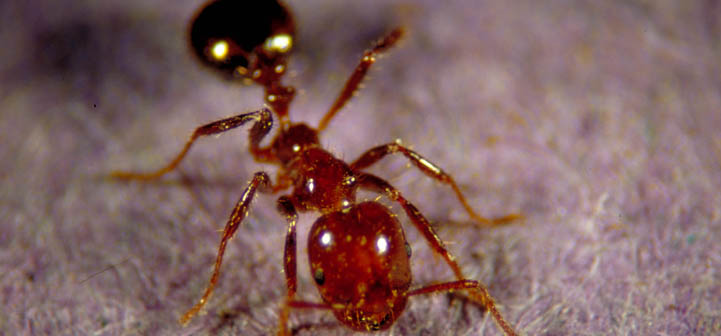FA Youth Home > List of Exercises > What’s a Fire Ant to Eat?
Activity: What’s a Fire Ant to Eat?
Overview
Learn about the diet of imported fire ants by offering them fats, proteins and carbohydrates (sugars). Observe their attraction (or lack thereof) to the various foods.
Objective
Be able to identify the food types and landscape areas that are most attractive to fire ants.
Safety Tips
- Worker fire ants will sting so watch out where you place your hands!
- First aid for fire ant stings: Commercially available sting medications can help relieve the stinging. Washing the stings with soap and water will clean the area and help reduce the chances of secondary infection. Some individuals may experience allergic reactions to the bites. Refer to the Fire Ant Project Fact Sheet, Medical Problems and Treatment Considerations for the Red Imported Fire Ant (ENTO-005), for more information on medical issues.
- You should not scratch the sting or rupture the pustule that might occur at the sting site because secondary infections may occur. The pustule is a normal result of a fire ant sting and is sterile unless ruptured.
Materials
- 5-10 bait stations (note cards or another type of heavy paper)
- Permanent markers
- Pens or pencils
- Food items: choose 5-10 different types of foods such as olive oil, canned tuna, potato chips, Vienna sausage, honey, peanuts, sunflower seeds, dry dog food, citrus peels, molasses, chocolate chips, peppermints, or any other foods high in fats, proteins, or sugar
- Soap
- Sting medications
- Data Observation Sheet
Instructions
- Before beginning the outdoor activities make sure that you read and understand the Safety Tips listed above.
- Label each of the bait stations with the name of the food that will be placed on it.
- Place the bait stations with different foods at equal distances around large fire ant mounds to see which foods are most attractive and least attractive. Bait stations may be placed from 6 to 12 inches from the mound in a circular pattern. If the outdoor temperature is above 70 degrees Fahrenheit, ants should find the foods within 15 minutes. If outdoor temperatures are slightly cooler than this, it may take 30 minutes or longer for the fire ants to visit the bait stations. If temperatures are cooler than 60 degrees Fahrenheit or hotter than 95 degrees Fahrenheit, fire ants may not emerge from the ground at all.
- While waiting for the ants to find the bait, you might want to look around and see where the fire ant mounds are located. For example, are they in sunny or shady areas?
- Use the Data Observation Sheet to record your observations: favorite and least favorite ant foods, time until ants found the food, numbers of ants at the food (many, few, none). You may also record whether other types of ants came to the food and the relative size of the mound (large, medium, small) that you selected to test. Weather conditions such as temperature and sky condition (cloudy, clear, partly cloudy, etc.) should be recorded for reference.
Wrap-up
- Which food types were most attractive? Which were the least attractive?
- Did the ants avoid any of the foods altogether? Why do you think they avoided a food selection? How would the feeding activities be different under different weather conditions?
- Have the students write a short paragraph about the types of food you used and which ones attracted more ants. Where do they think ants fit into the food chain?
Additional Information for Instructors
To use this as a large group exercise:
If you have a large number of students, a helper or assistant is recommended to make sure all students perform this activity safely.
- Before beginning the outdoor activities, discuss fire ant safety.
- Have the students label each of the bait stations with the name of the food that will be placed on it.
- Then they should place the bait stations with different foods at equal distances around large fire ant mounds to see which foods are most attractive and least attractive. Bait stations may be placed from 6 to 12 inches from the mound in a circular pattern. If the outdoor temperature is above 70 degrees Fahrenheit, ants should find the foods within 15 minutes. If outdoor temperatures are slightly cooler than this, it may take 30 minutes or longer for the fire ants to visit the bait stations. If temperatures are cooler than 60 degrees Fahrenheit or hotter than 95 degrees Fahrenheit, fire ants may not emerge from the ground at all.
- While waiting for the ants to find the bait, you may opt to do some other activity with the students such as gathering weather information or examining the area to see where fire ant mounds are located and whether they are in sunny or shady areas.
- Students should use the Data Observation Sheet to record their observations: favorite and least favorite ant foods, time until ants found the food, numbers of ants at the food (many, few, none). They may also record whether other types of ants came to the food and the relative size of the mound (large, medium, small) that they selected to test. Weather conditions such as temperature and sky condition (cloudy, clear, partly cloudy, etc.) should be recorded for reference.
You may want to refer to the original KIDzANTS Teacher Manual, which was included in the original release of the KIDzANTS Red Imported Fire Ant Youth module developed by the Texas A&M AgriLife Extension Service.
| << Previous: Making Casts of Fire Ant Mounds | List of Exercises | >> Next Exercise: What Do You Like to Eat? |
